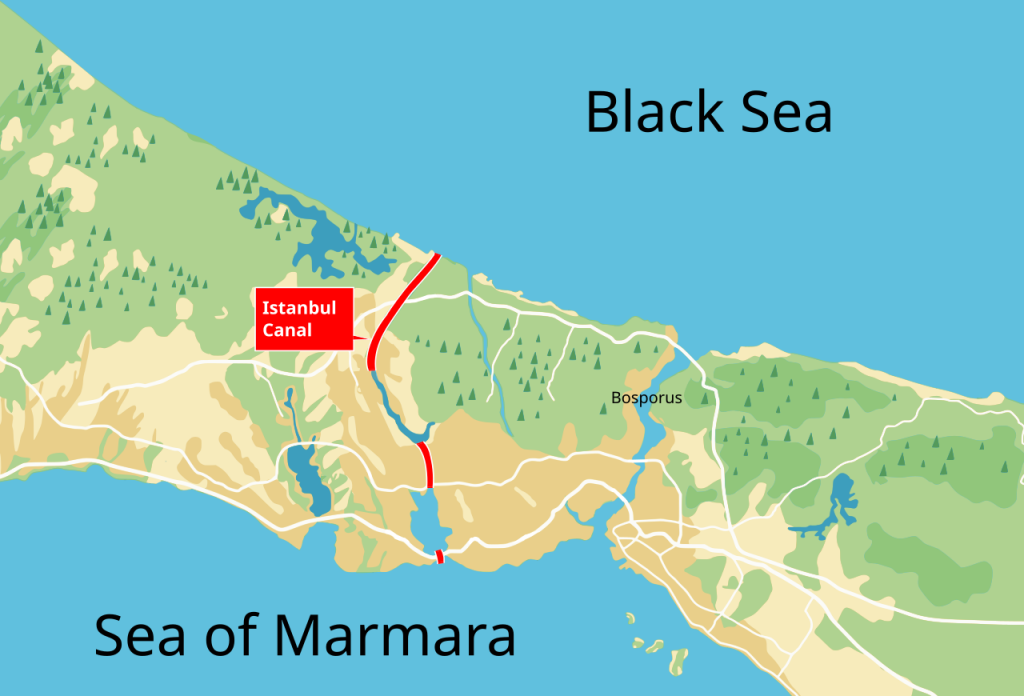Turkey's proposed new waterway, 'Canal Istanbul', would connect the Black Sea with the Sea of Marmara. Sezen Kaya Sönmez describes how the project is about more than just transport, but has geopolitical, ecological, and climate aspects. Digging a new maritime corridor, she argues, threatens environmental resilience, regional stability, and long-term security
Often framed as a solution to growing sea-traffic congestion, the Canal Istanbul proposal revives a centuries-old idea. The Canal is a response to current practical needs, but also reflects deep strategic ambition. Turkey's government is presenting the project as a solution to maritime congestion and navigational risk in the Bosphorus. The full implications of the Canal, however, might extend far beyond domestic urban planning or maritime efficiency.
The Canal Istanbul project introduces complex security dynamics that clash with global priorities on economic resilience, water governance, ecological fragility, and climate vulnerability. This would make the Canal not just a strategic corridor but a potential security risk.

Transport and Infrastructure Minister Abdulkadir Uraloğlu described the Canal Istanbul project as 'a need for Türkiye'. The project responds to modern maritime challenges with a vision rooted in centuries of strategic ambition. The idea to build a waterway linking the Black Sea and the Sea of Marmara was discussed by Governor Pliny and Emperor Trajan in Roman times. In the 16th century, under the reign of Suleiman the Magnificent, Ottoman architects Mimar Sinan and Nicola Parisi designed a similar route, which was ultimately suspended amid military pressures.
The idea re-emerged in the early 1990s, and gained political momentum in 2011, when then-Prime Minister Recep Tayyip Erdoğan officially announced the project. Construction formally began in June 2021.
The Canal Istanbul project aims to ease heavy shipping traffic in the Bosphorus and reduce the environmental risks posed by vessels carrying hazardous materials
The proposed Canal is 45km long, with a minimum width of 275m and a depth of 20.75m. Its aim is to ease heavy shipping traffic in the Bosphorus and reduce the environmental risks posed by vessels carrying hazardous materials, ensuring safer and more efficient navigation.
The architects of this project present it as a practical solution to growing maritime traffic. Yet the Canal's proposed route crosses various sensitive zones, including wetlands, aquifers, and agricultural lands. Only 4% of the reserve area is residential; 51% is agricultural, 5% forest, and 13% meadows and shrublands. Turning this into urban and logistics zones threatens biodiversity and environmental security.
The Canal’s carbon footprint adds to the concern. The project will generate an estimated 1.34 million tonnes of CO₂ annually during construction, and an extra 200,000 tonnes during operation. These figures exclude emissions from a new urban development that will accompany the Canal. Nor do they include additional emissions associated with population relocation and increased energy demand. The resulting carbon emissions may challenge Turkey’s climate commitments.
During construction of the Canal, deforestation may cause urban heat islands to emerge. The destruction of agricultural land may also worsen food security
Urban heat islands are likely to emerge as a result of increased construction and deforestation. The destruction of fertile agricultural land may worsen food security, particularly in Istanbul, which is already vulnerable to supply shocks and rising temperatures.
Canal Istanbul could alter water salinity, and affect currents between the Black Sea and the Sea of Marmara. Marine biologists have raised questions about nutrient loading and eutrophication risks, which could further damage marine ecosystems. A 38km coastal landfill for excavation waste may disrupt Black Sea marine life and fisheries, depleting biodiversity locally and beyond.
The Canal's proposed route traverses multiple active faultlines. Surveys in 2014 and 2016 revealed 28 fault segments, including one beneath Küçükçekmece Lake with a horizontal movement rate of 5mm per year. In the event of an earthquake of 7.2 magnitude or higher, potential outcomes include flooding, lagoon destruction, or even a tsunami from underwater landslides.
This geoseismic context introduces uncertainty to long-term urban planning. The prospect of building dense settlements in such zones raises questions about risk preparedness, disaster management capacity, and long-term resilience. Soil instability and the existing landslide zones between Büyükçekmece and Küçükçekmece intensify these concerns.
Canal Istanbul would physically separate the western districts of Istanbul from mainland Europe, effectively creating a densely populated artificial island. Such isolation may inflict irreversible damage on migratory species, habitat continuity, and the broader functioning of natural systems.
Canal Istanbul is more than an infrastructure project: it is an interface between the environment, maritime sovereignty, and regional power politics
A widely discussed implication of the Canal project relates to the Montreux Convention of 1936, which governs passage through the Turkish Straits. Turkish officials assert that the Canal will not undermine the convention, because it is an alternative, not a replacement, for the Bosphorus. Nonetheless, analysts note that the legal status of the new waterway remains undefined.
Such ambiguity introduces strategic unpredictability in a region already fraught with tensions over Crimea, the Russia-Ukraine War, and naval militarisation. This makes the Canal more than an infrastructure project: an interface between the environment, maritime sovereignty, and regional power politics.
Canal Istanbul exemplifies how an infrastructure project can evolve into a multidimensional security risk. This is especially worrying when we consider Turkey's fragile ecological systems, contested geopolitical arenas, and a rapidly changing climate.
The project is not inherently destabilising. But it raises a series of challenges that extend beyond its initial framing. By transforming land use and changing hydro-geological systems, the Canal could worsen vulnerabilities that Turkey lacks the capacity to handle. It could transform a domestic megaproject into a climate risk.
Canal Istanbul is more than a feat of engineering; it is a forerunner of the kind of dilemmas the 21st century will increasingly face, in which national ambition clashes with ecological boundaries. Ecosystems are collapsing, climate systems are destabilising, and trust in regional cooperation is fraying. In these troubling times, more and more people are questioning the logic of carving new waterways through fragile geographies.
A great take! Thank you!